By Leen Randell
Updated: Jul 04, 2024
10 Best Herbal Decoctions For Bloating
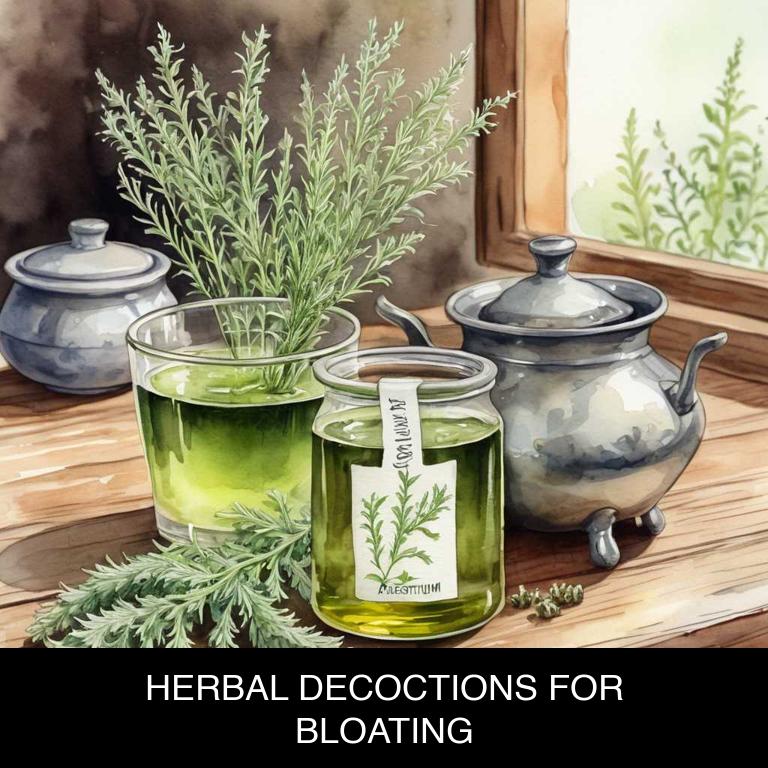
Herbal decoctions for bloating are a natural and effective way to alleviate discomfort and reduce gas and pressure in the abdominal region.
By infusing herbs such as peppermint, ginger, and chamomile into hot water, these decoctions help soothe the digestive system and ease symptoms of bloating. For example, peppermint helps relax the muscles in the digestive tract, while ginger has natural anti-inflammatory properties that reduce inflammation and improve digestion.
With regular use, these herbal decoctions can significantly improve one's quality of life by providing relief from bloating-related discomfort, allowing individuals to feel more relaxed, confident, and comfortable in their own skin.
The following article describes in detail the most important decoctions for bloating, including medicinal properties, parts of herbs to use, and recipes for preparations.
- 1. Artemisia absinthium
- 2. Foeniculum vulgare
- 3. Myrrhis odorata
- 4. Mentha x piperita
- 5. Taraxacum officinale
- 6. Matricaria chamomilla
- 7. Glycyrrhiza glabra
- 8. Althaea officinalis
- 9. Urtica dioica
- 10. Rumex crispus
- What is the best combination of herbal decoctions to use for bloating?
- What ailments similar to bloating are treated with herbal decoctions?
1. Artemisia absinthium
Wormwood decoctions helps with bloating because its bitter compounds stimulate digestive enzymes, enhancing gut motility and reducing inflammation in the digestive tract.
The herb's anthraquinones also have a natural laxative effect, promoting regular bowel movements and eliminating excess gas and water that can contribute to bloating.
Additionally, wormwood has anti-spasmodic properties, which help relax the muscles in the digestive tract and reduce cramps, further alleviating symptoms of bloating.
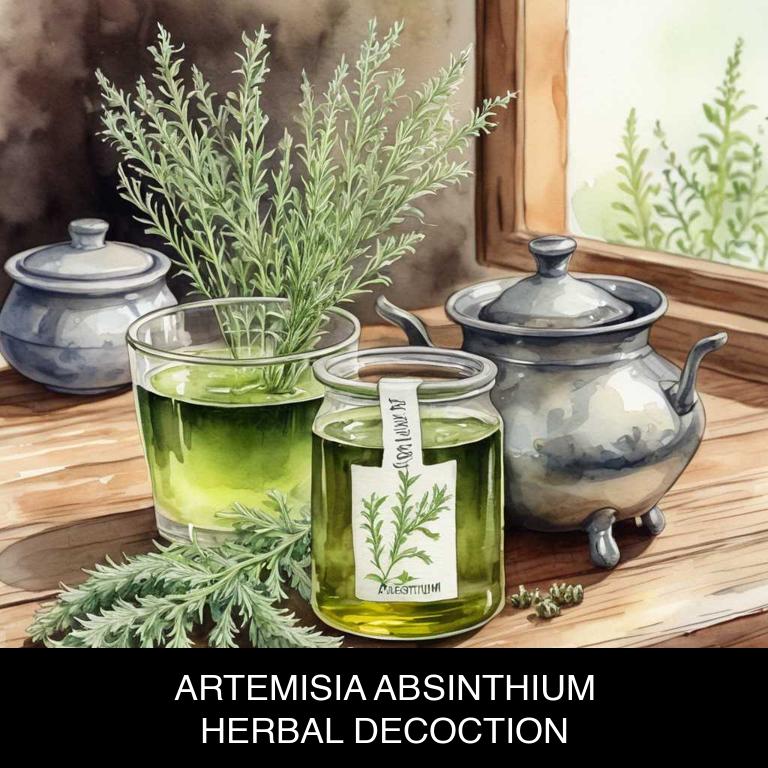
Medicinal Constituents
The list below shows the primary medicinal constituents in Artemisia absinthium decoctions that help with bloating.
- Artabsin: This sesquiterpene lactone has anti-inflammatory properties, which can help reduce inflammation in the digestive tract that may contribute to bloating.
- Absinthin: This sesquiterpene lactone has spasmolytic effects, relaxing the smooth muscles in the digestive tract and reducing cramping and discomfort associated with bloating.
- Thujone: This terpene has carminative properties, helping to relieve gas and flatulence by reducing the production of gas in the digestive system and promoting its release.
Parts Used
The list below shows the primary parts of wormwood used to make decoctions for bloating.
- Leaves: They are used due to their high concentration of volatile oils, which have carminative properties that help to relieve bloating.
- Stems: The stems of Artemisia absinthium are used in decoctions because they contain compounds that help to stimulate digestion and alleviate symptoms of bloating.
- Roots: The roots are used to make decoctions for bloating because they contain a high concentration of bitter compounds that help to stimulate digestion and relieve symptoms of bloating.
Quick Recipe
The following recipe gives a procedure to make a basic wormwood for bloating.
- Gather 1/4 cup of dried artemisia absinthium leaves and flowers and 1 quart of water for the decoction.
- Combine the dried herbs in a saucepan with the water and bring to a boil over high heat.
- Reduce the heat to medium-low and simmer the mixture for 10 to 15 minutes to release the active compounds.
- Strain the liquid through a cheesecloth or a fine-mesh sieve into a clean container to remove the solids.
- Allow the decoction to cool before refrigerating or freezing it for later use as needed.
2. Foeniculum vulgare
Fennel decoctions helps with bloating because of its natural anti-inflammatory properties, which reduce swelling in the digestive tract.
The essential oils present in fennel seeds also help to relax the muscles in the stomach and intestines, relieving pressure and discomfort associated with bloating. Additionally, fennel's carminative properties help to break down gas in the gut, reducing its accumulation and alleviating symptoms of bloating, indigestion, and cramps.
By soothing and calming the digestive system, fennel decoctions promote a healthy and balanced gut.
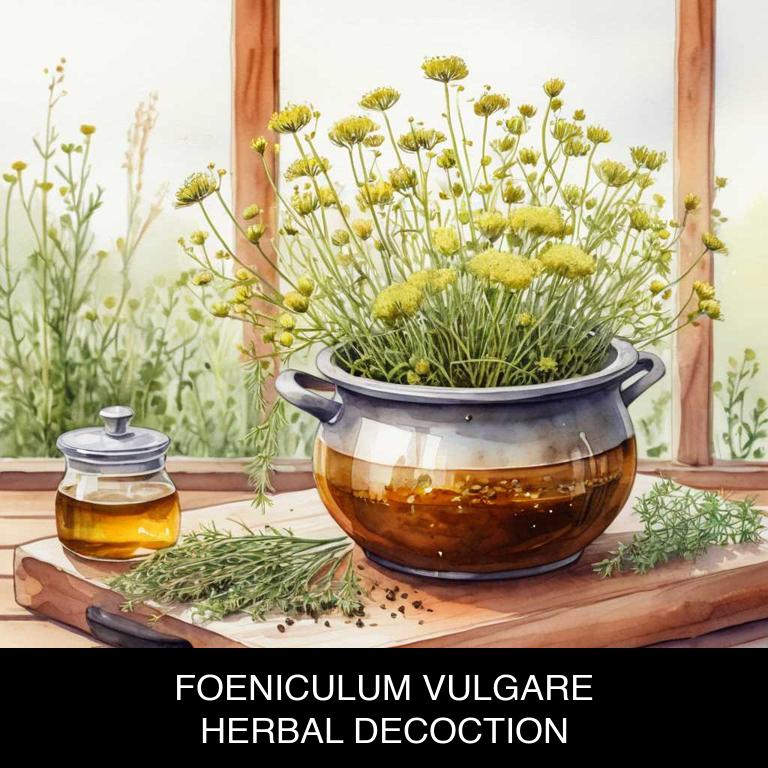
Medicinal Constituents
The list below shows the primary medicinal constituents in Foeniculum vulgare decoctions that help with bloating.
- Foeniculin: It helps with bloating by reducing gas in the digestive tract and alleviating symptoms of irritable bowel syndrome (IBS) due to its carminative properties.
- Anethole: It helps with bloating by relaxing the muscles in the digestive tract, reducing spasms, and improving digestion, which eases the discomfort associated with bloating.
- Phenolic acids: They help with bloating by reducing inflammation in the digestive tract and improving the gut microbiome, which in turn helps to alleviate bloating and other IBS symptoms.
Parts Used
The list below shows the primary parts of fennel used to make decoctions for bloating.
- Leaves: Leaves are commonly used due to their essential oils, particularly anethole, which helps to relax the digestive muscles and reduce bloating.
- Seeds: Seeds are often used because they contain a high concentration of anethole, which has carminative properties that help to relieve gas and bloating.
- Roots: Roots are sometimes used for their ability to stimulate digestion and relieve bloating, possibly due to the presence of volatile oils and other compounds that aid in gut health.
Quick Recipe
The following recipe gives a procedure to make a basic fennel for bloating.
- Measure out 1 teaspoon of dried foeniculum vulgare seeds and add to a saucepan.
- Pour 1 cup of boiling water over the foeniculum vulgare seeds in the saucepan.
- Reduce heat to a simmer and let the mixture steep for 5 to 10 minutes.
- Strain the liquid through a fine-mesh sieve or cheesecloth into a cup.
- Discard the solids and drink the warm foeniculum vulgare decoction immediately.
3. Myrrhis odorata
Sweet cicely decoctions helps with bloating because its unique blend of volatile oils, flavonoids, and anthocyanins has a calming effect on the digestive system.
The herbal remedy soothes irritated tissues in the gut, reducing inflammation and discomfort associated with bloating. Additionally, sweet cicely's natural carminative properties help to ease gas and flatulence, allowing for more efficient digestion and relief from bloated feelings.
By promoting a balanced gut microbiome, sweet cicely decoctions support overall digestive health and reduce symptoms of bloating.
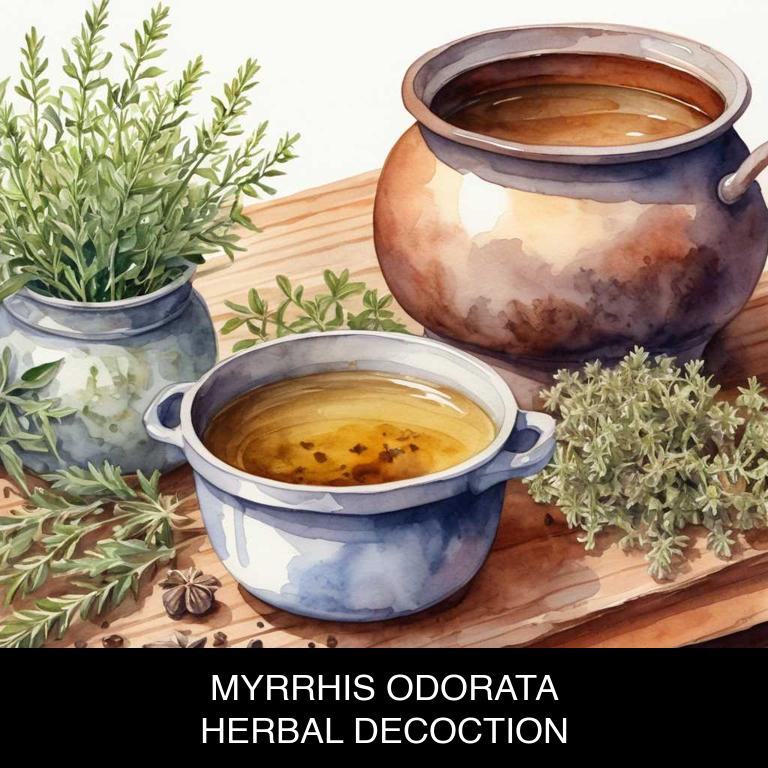
Medicinal Constituents
The list below shows the primary medicinal constituents in Myrrhis odorata decoctions that help with bloating.
- Furanocoumarins: These compounds may help with bloating by inhibiting the growth of gut bacteria, which can contribute to gas and discomfort.
- Phenolic acids: These antioxidants may reduce inflammation in the digestive tract, alleviate bloating symptoms, and improve gut motility.
- Terpenes: Certain terpenes found in sweet cicely, such as beta-pinene and limonene, have anti-inflammatory and carminative properties, which can help alleviate bloating and gas.
Parts Used
The list below shows the primary parts of sweet cicely used to make decoctions for bloating.
- Roots: Used due to their carminative properties that help to ease digestive discomfort and alleviate bloating.
- Leaves: Used due to their anti-inflammatory and antispasmodic properties that help to soothe digestive issues and reduce bloating.
- Stems: Used due to their ability to stimulate digestion and relieve digestive discomfort, which in turn helps to alleviate bloating.
Quick Recipe
The following recipe gives a procedure to make a basic sweet cicely for bloating.
- Gather 2-3 grams of dried myrrhis odorata root and 1-2 grams of dried leaves.
- Crush the dried plant material using a mortar and pestle for 1-2 minutes.
- Combine the crushed myrrhis odorata root and leaves with 250 milliliters of boiling water.
- Steep the mixture for 10-15 minutes or until the liquid has cooled to room temperature.
- Strain the decoction through a cheesecloth or fine-mesh sieve into a clean container.
4. Mentha x piperita
Peppermint decoctions helps with bloating because it relaxes the muscles in the digestive tract, reducing spasms and cramping that can contribute to discomfort.
The menthol content in peppermint also has a cooling effect on the stomach, which can help soothe irritable bowel syndrome (IBS) symptoms like bloating.
Additionally, peppermint decoctions may improve digestion by increasing the movement of food through the digestive system, reducing the amount of time that food sits in the gut and causes bloating.

Medicinal Constituents
The list below shows the primary medicinal constituents in Mentha x piperita decoctions that help with bloating.
- Limonene: Acts as a carminative agent by reducing stomach contractions and relieving gas and bloating.
- Menthol: Exhibits analgesic and anti-inflammatory properties, which can help alleviate discomfort and pain associated with bloating.
- Rosmarinic acid: Possesses antioxidant and anti-inflammatory properties, which may help reduce inflammation and alleviate symptoms of bloating and digestive discomfort.
Parts Used
The list below shows the primary parts of peppermint used to make decoctions for bloating.
- Leaves: Used for decoctions to alleviate bloating due to their high concentration of menthol and menthone, which have carminative properties.
- Roots: Utilized in decoctions to reduce bloating because they contain a higher concentration of menthol than the leaves, promoting digestion and alleviating discomfort.
- (optional) stems: Sometimes used in decoctions for bloating relief due to their ability to aid in digestion and reduce gas, although their effectiveness is less pronounced compared to leaves and roots.
Quick Recipe
The following recipe gives a procedure to make a basic peppermint for bloating.
- Harvest 20-30 grams of fresh mentha x piperita leaves and flowers in the early morning.
- Chop the harvested leaves and flowers into small pieces to increase their surface area.
- Combine 20-30 grams of chopped leaves and flowers with 1 liter of boiling water in a saucepan.
- Steep the mixture for 5-10 minutes to allow the active compounds to infuse into the water.
- Strain the decoction through a cheesecloth or a fine-mesh sieve into a clean container.
5. Taraxacum officinale
Dandelion decoctions helps with bloating because its diuretic properties help to increase urine production, reducing water retention and alleviating swelling.
The bitter compounds in dandelion also stimulate digestion and improve gut motility, preventing food from lingering in the digestive system and reducing the likelihood of bloating. Additionally, dandelion's anti-inflammatory effects may help soothe irritated intestines and reduce inflammation that can contribute to bloating.
As a result, regular consumption of dandelion decoctions can provide natural relief from bloating and promote overall digestive health.

Medicinal Constituents
The list below shows the primary medicinal constituents in Taraxacum officinale decoctions that help with bloating.
- Taraxasterol: This triterpene has anti-inflammatory properties, which can help reduce inflammation in the digestive tract that may contribute to bloating.
- Inulin: A type of fructan, inulin can help regulate gut bacteria and improve digestion, reducing symptoms of bloating and discomfort.
- Luteolin: This flavonoid has anti-spasmodic and anti-inflammatory effects, which can help alleviate cramping and discomfort associated with bloating.
Parts Used
The list below shows the primary parts of dandelion used to make decoctions for bloating.
- Roots: The roots are the primary part used due to their high concentration of saponins, which have anti-inflammatory and antispasmodic properties to help alleviate bloating.
- Leaves: The leaves are used for their bitter compounds, which can help stimulate digestion and relieve bloating by improving gut motility.
- Seeds: The seeds contain inulin, a prebiotic fiber that promotes gut health, reduces inflammation, and alleviates symptoms of bloating.
Quick Recipe
The following recipe gives a procedure to make a basic dandelion for bloating.
- Gather 10-20 fresh taraxacum officinale roots, washed thoroughly, and chop them into small pieces.
- Steep the chopped roots in 1 liter of boiling water for 10-15 minutes, covered.
- Strain the liquid through a cheesecloth or a fine-mesh sieve into a clean container.
- Discard the solids and let the decoction cool to room temperature, which takes about 30 minutes.
- Store the cooled decoction in a glass bottle in the refrigerator for up to 2 days.
6. Matricaria chamomilla
Chamomile decoctions helps with bloating because of its soothing and anti-inflammatory properties.
The apigenin and luteolin present in chamomile work to calm down the digestive system, reducing muscle spasms and cramps that can contribute to bloating. Additionally, chamomile's natural relaxant properties help ease anxiety and stress, which are common triggers for bloating.
By calming the digestive tract and promoting a sense of relaxation, chamomile decoctions can effectively alleviate symptoms of bloating and leave you feeling lighter and more comfortable.

Medicinal Constituents
The list below shows the primary medicinal constituents in Matricaria chamomilla decoctions that help with bloating.
- Apigenin: This flavonoid helps with bloating by relaxing smooth muscle in the digestive tract, thereby reducing spasms and cramping associated with bloating.
- Luteolin: This flavonoid has anti-inflammatory properties, which help reduce inflammation in the digestive tract and alleviate symptoms of bloating.
- Bornyl acetate: This terpene acts as a carminative, helping to release trapped gas in the digestive system and provide relief from bloating and discomfort.
Parts Used
The list below shows the primary parts of chamomile used to make decoctions for bloating.
- Flowers: The flowers are used due to their anti-inflammatory properties and soothing effects, which can help alleviate bloating and digestive discomfort.
- Leaves: The leaves are used for their carminative properties, helping to ease bloating and gas by reducing the formation of gas in the digestive system.
- Seeds: The seeds are used due to their antispasmodic properties, which can help relax the muscles in the digestive system and alleviate symptoms of bloating and cramps.
Quick Recipe
The following recipe gives a procedure to make a basic chamomile for bloating.
- Harvest 1 ounce of dried matricaria chamomilla flowers or 2 ounces of fresh flowers.
- Combine the harvested flowers with 32 ounces of boiling water in a heat-resistant container.
- Steep the mixture for 5 to 7 minutes to allow the active ingredients to infuse.
- Strain the decoction through a cheesecloth or a fine-mesh sieve into a separate container.
- Store the cooled decoction in an airtight container in the refrigerator for up to 24 hours.
7. Glycyrrhiza glabra
Licorice decoctions helps with bloating because they contain glycyrrhizin, a compound that has anti-inflammatory properties.
This helps to reduce inflammation in the digestive tract, which can contribute to bloating and discomfort. Additionally, licorice root has been shown to have prebiotic properties, promoting the growth of beneficial gut bacteria, which can aid digestion and alleviate symptoms of bloating.
By soothing and regulating the digestive system, herbal licorice decoctions can provide relief from uncomfortable bloating and promote a healthier gut.

Medicinal Constituents
The list below shows the primary medicinal constituents in Glycyrrhiza glabra decoctions that help with bloating.
- Glycyrrhizin: It helps with bloating by inhibiting the enzyme 11β-hydroxysteroid dehydrogenase, which reduces inflammation and swelling in the digestive tract.
- Licoricidin: It helps with bloating by acting as a prebiotic, promoting the growth of beneficial gut bacteria and improving digestion, thereby reducing symptoms of bloating.
- Licopyrone: It helps with bloating by exhibiting anti-inflammatory properties, reducing inflammation in the digestive tract and alleviating symptoms of bloating and discomfort.
Parts Used
The list below shows the primary parts of licorice used to make decoctions for bloating.
- Roots: Used due to their high glycyrrhizin content, which helps to reduce inflammation and alleviate symptoms of bloating.
- Roots: Also used because they contain antioxidants and anti-inflammatory compounds that help to soothe digestive issues and reduce bloating.
- Roots: Furthermore, roots are used for their carminative properties, which help to ease digestion and relieve discomfort associated with bloating.
Quick Recipe
The following recipe gives a procedure to make a basic licorice for bloating.
- Harvest 2-3 roots of glycyrrhiza glabra from a trusted supplier for medicinal use.
- Clean the roots thoroughly with lukewarm water to remove any dirt or debris.
- Chop 1-2 grams of the cleaned roots into smaller pieces to increase surface area.
- Steep the chopped roots in 100-200 milliliters of boiling water for 5-10 minutes.
- Strain the liquid through a fine-mesh sieve and discard the solids to obtain the decoction.
8. Althaea officinalis
Marshmallow decoctions helps with bloating because they work to soothe and calm the digestive tract, reducing inflammation and irritation that can contribute to discomfort and swelling.
The mucilages in marshmallow roots bind to water and form a protective coating on the gut lining, gently coating and lubricating the digestive tract, allowing food to pass through more easily and reducing bloating symptoms.
This natural remedy can also help regulate digestion and promote regular bowel movements, further alleviating bloating and discomfort.

Medicinal Constituents
The list below shows the primary medicinal constituents in Althaea officinalis decoctions that help with bloating.
- Mucilages: Mucilages help with bloating by forming a protective barrier on the mucous membranes, reducing inflammation and irritation in the digestive tract, and promoting the elimination of gas and toxins.
- Glucuronic acid: Glucuronic acid helps with bloating by stimulating the production of mucus, which helps to trap and eliminate gas and toxins in the digestive tract, and also by having anti-inflammatory properties.
- Triterpenoid saponins: Triterpenoid saponins help with bloating by having anti-inflammatory and soothing effects on the digestive tract, reducing inflammation and irritation that can contribute to bloating and discomfort.
Parts Used
The list below shows the primary parts of marshmallow used to make decoctions for bloating.
- Roots: They are the most commonly used part due to their high mucilage content, which helps soothe the digestive system and reduce bloating.
- Leaves: Leaves are also used to make decoctions, as they contain flavonoids and other compounds that may help alleviate bloating and other digestive issues.
- Stems: Stems of Althaea officinalis are sometimes used, as they contribute to the overall mucilage content of the decoction and may aid in digestion and reducing bloating.
Quick Recipe
The following recipe gives a procedure to make a basic marshmallow for bloating.
- Gather 2-3 tablespoons of dried althaea officinalis root and place it in a clean glass container.
- Boil 1 quart of water in a saucepan and add the dried root to the boiling water.
- Reduce the heat to a simmer and let it steep for 10-15 minutes to infuse the liquid.
- Strain the decoction through a cheesecloth or a coffee filter into another container to remove the solids.
- Allow the decoction to cool completely before transferring it to a glass bottle for storage.
9. Urtica dioica
Stinging nettle decoctions helps with bloating because of its natural anti-inflammatory properties, which soothe and calm the digestive system.
The decoction's ability to reduce inflammation in the intestines and colon helps alleviate symptoms of bloating, such as gas, discomfort, and abdominal cramping. Additionally, stinging nettle contains mucilages that help bind to water and ease digestion, further reducing bloating.
By promoting a healthy gut environment, stinging nettle decoctions support overall digestive health and provide relief from uncomfortable bloating symptoms.

Medicinal Constituents
The list below shows the primary medicinal constituents in Urtica dioica decoctions that help with bloating.
- Flavonoids: These plant compounds help with bloating by reducing inflammation and improving gut motility, which can alleviate digestive discomfort.
- Triterpenoids: This compound exhibits anti-inflammatory properties, which can help soothe and calm the digestive tract, reducing bloating and discomfort.
- Phenolic acids: These compounds have antioxidant and anti-inflammatory properties, which can help protect the gut from damage and reduce inflammation that may contribute to bloating.
Parts Used
The list below shows the primary parts of stinging nettle used to make decoctions for bloating.
- Leaves: They contain bioactive compounds that help alleviate bloating symptoms by regulating digestive enzymes and reducing inflammation.
- Roots: They contain steroidal saponins that help to reduce inflammation and ease bloating discomfort.
- Stems: They have anti-inflammatory properties that can help to calm digestive issues and alleviate bloating.
Quick Recipe
The following recipe gives a procedure to make a basic stinging nettle for bloating.
- Harvest 1/4 cup of fresh urtica dioica leaves and stems on a sunny day when they are free of rain.
- Clean the urtica dioica leaves and stems thoroughly with lukewarm water to remove any dirt or debris.
- Boil 2 cups of water in a pot and add the urtica dioica leaves and stems for 10 minutes to make a decoction.
- Strain the decoction through a cheesecloth or a fine-mesh sieve into a bowl to remove the solids.
- Store the decoction in the refrigerator for up to 3 days or freeze it for later use.
10. Rumex crispus
Curly dock decoctions helps with bloating because it contains anthraquinone glycosides, which have a soothing effect on the digestive system.
These compounds help to reduce inflammation and spasms in the intestines, allowing for smoother digestion and elimination of toxins. Additionally, curly dock's anti-inflammatory properties can help to calm an irritated gut lining, reducing symptoms of bloating such as discomfort and pain.
As a result, drinking curly dock decoctions can provide relief from bloating and promote a sense of digestive well-being.
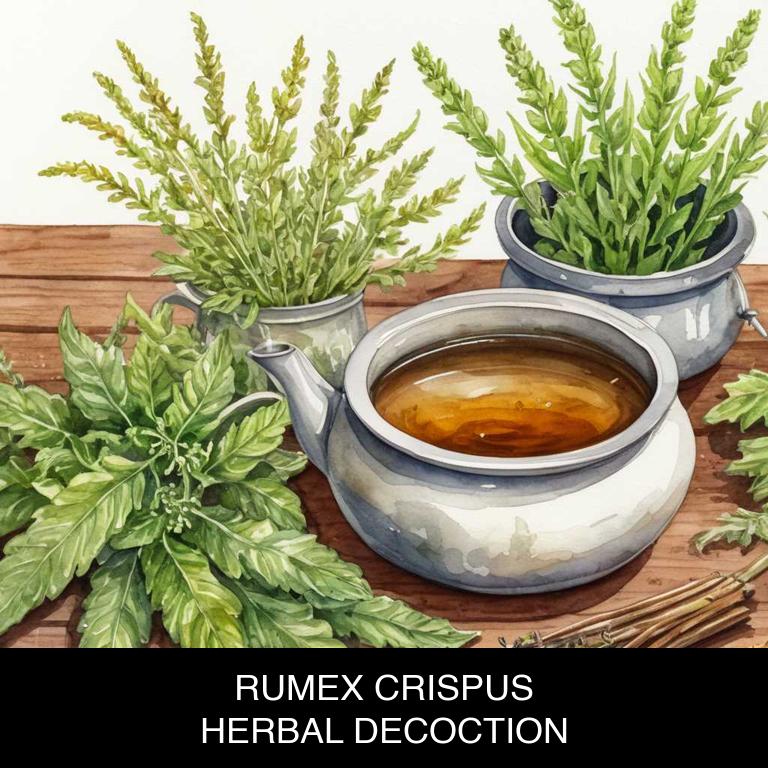
Medicinal Constituents
The list below shows the primary medicinal constituents in Rumex crispus decoctions that help with bloating.
- Anthraquinones: These compounds help alleviate bloating by stimulating bowel movements and relieving constipation, which is often a contributing factor to bloating.
- Flavonoids: As a potent antioxidant and anti-inflammatory agent, quercetin helps reduce inflammation in the digestive tract, which can contribute to bloating and discomfort.
- Triterpenoids: These compounds have been shown to have a relaxing effect on the smooth muscle in the digestive tract, which can help alleviate cramps and discomfort associated with bloating.
Parts Used
The list below shows the primary parts of curly dock used to make decoctions for bloating.
- Roots: They are used due to their diuretic and carminative properties, which help alleviate bloating.
- Leaves: They are used because of their ability to reduce inflammation and relieve digestive issues associated with bloating.
- Stems: They are used due to their content of flavonoids and other compounds that help soothe digestive issues and reduce bloating.
Quick Recipe
The following recipe gives a procedure to make a basic curly dock for bloating.
- Gather 20 grams of dried rumex crispus roots and 50 grams of the aerial parts.
- Crush the rumex crispus roots and aerial parts into a fine powder using a mortar and pestle.
- Combine 2 grams of the powdered rumex crispus with 200 milliliters of boiling water in a heat-resistant glass cup.
- Steep the mixture for 5-10 minutes and then strain it through a cheesecloth or a fine-mesh sieve.
- Discard the solids and let the liquid decoction cool to room temperature before consumption.
What is the best combination of herbal decoctions to use for bloating?
The best combination of herbal decoctions that help with bloating is a blend of Peppermint, Ginger, and Fennel.
Peppermint aids digestion and reduces inflammation, while Ginger calms the stomach and alleviates nausea. Fennel, rich in carminatives, helps to break down gas and relieve abdominal discomfort. This trio can be steeped together in hot water to create a soothing tea that promotes relaxation and eases bloating symptoms.
Regular consumption may help regulate digestive function and promote overall well-being.
What ailments similar to bloating are treated with herbal decoctions?
Ailments similar to bloating/decoctions.html">bloating/decoctions.html">bloating that are treated with herbal decoctions are digestive disorders such as constipation, diarrhea, and indigestion.
Herbal decoctions like peppermint, chamomile, and licorice root are used to soothe the stomach and alleviate symptoms of irritable bowel syndrome (IBS). Ginger and fennel decoctions can also help to relieve nausea and reduce inflammation in the digestive tract.
These herbal remedies work by relaxing the muscles, reducing spasms, and promoting regular bowel movements.